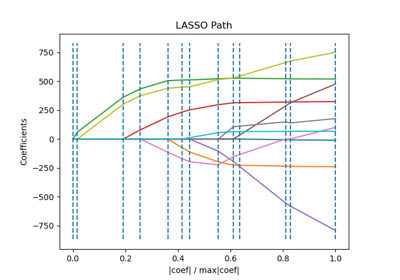W3cubDocs
/scikit-learnsklearn.linear_model.lars_path
-
sklearn.linear_model.lars_path(X, y, Xy=None, Gram=None, max_iter=500, alpha_min=0, method='lar', copy_X=True, eps=2.2204460492503131e-16, copy_Gram=True, verbose=0, return_path=True, return_n_iter=False, positive=False)[source] -
Compute Least Angle Regression or Lasso path using LARS algorithm [1]
The optimization objective for the case method=’lasso’ is:
(1 / (2 * n_samples)) * ||y - Xw||^2_2 + alpha * ||w||_1
in the case of method=’lars’, the objective function is only known in the form of an implicit equation (see discussion in [1])
Read more in the User Guide.
Parameters: X : array, shape: (n_samples, n_features)
Input data.
y : array, shape: (n_samples)
Input targets.
positive : boolean (default=False)
Restrict coefficients to be >= 0. When using this option together with method ‘lasso’ the model coefficients will not converge to the ordinary-least-squares solution for small values of alpha (neither will they when using method ‘lar’ ..). Only coefficients up to the smallest alpha value (
alphas_[alphas_ > 0.].min()when fit_path=True) reached by the stepwise Lars-Lasso algorithm are typically in congruence with the solution of the coordinate descent lasso_path function.max_iter : integer, optional (default=500)
Maximum number of iterations to perform, set to infinity for no limit.
Gram : None, ‘auto’, array, shape: (n_features, n_features), optional
Precomputed Gram matrix (X’ * X), if
'auto', the Gram matrix is precomputed from the given X, if there are more samples than features.alpha_min : float, optional (default=0)
Minimum correlation along the path. It corresponds to the regularization parameter alpha parameter in the Lasso.
method : {‘lar’, ‘lasso’}, optional (default=’lar’)
Specifies the returned model. Select
'lar'for Least Angle Regression,'lasso'for the Lasso.eps : float, optional (default=``np.finfo(np.float).eps``)
The machine-precision regularization in the computation of the Cholesky diagonal factors. Increase this for very ill-conditioned systems.
copy_X : bool, optional (default=True)
If
False,Xis overwritten.copy_Gram : bool, optional (default=True)
If
False,Gramis overwritten.verbose : int (default=0)
Controls output verbosity.
return_path : bool, optional (default=True)
If
return_path==Truereturns the entire path, else returns only the last point of the path.return_n_iter : bool, optional (default=False)
Whether to return the number of iterations.
Returns: alphas : array, shape: [n_alphas + 1]
Maximum of covariances (in absolute value) at each iteration.
n_alphasis eithermax_iter,n_featuresor the number of nodes in the path withalpha >= alpha_min, whichever is smaller.active : array, shape [n_alphas]
Indices of active variables at the end of the path.
coefs : array, shape (n_features, n_alphas + 1)
Coefficients along the path
n_iter : int
Number of iterations run. Returned only if return_n_iter is set to True.
See also
lasso_path,LassoLars,Lars,LassoLarsCV,LarsCV,sklearn.decomposition.sparse_encodeReferences
[R182] “Least Angle Regression”, Effron et al. http://statweb.stanford.edu/~tibs/ftp/lars.pdf [R183] Wikipedia entry on the Least-angle regression [R184] Wikipedia entry on the Lasso
Examples using sklearn.linear_model.lars_path
© 2007–2016 The scikit-learn developers
Licensed under the 3-clause BSD License.
http://scikit-learn.org/stable/modules/generated/sklearn.linear_model.lars_path.html
